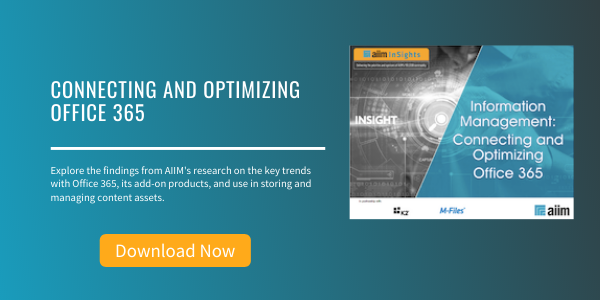
23 Things You Need to Know about Using SharePoint for ECM
Enterprise Content Management (ECM) | Sharepoint and Office 365
We just completed our research to understand how businesses are using SharePoint to support their ECM requirements. The study uncovered some interesting insights. Here some the highlights.
-
Only 8% of SharePoint users have completed their upgrade to the 2010 version, whereas 21% are deploying 2010 as a first use. Of these, 6% are live. 28% are in the process of upgrading from 2007 to 2010. Half of the user base expects to be live in 2010 or, by the end of 2011.
-
36% of responding organizations consider they have SharePoint “in use across the enterprise for content management.” Included are 11% with no other content systems, 19% running unconnected ECM/DM/RM systems running in parallel, and just 6% who have SharePoint fully integrated with other systems.
-
A third of organizations have 90-100% of active users with licensed access, predicted to grow to over half in 12 months' time.
-
IT is by far the most advanced department for adoption and use, followed by Line-of-Business – likely reflecting the widespread use for project management.
-
The IT department is in charge of SharePoint in all but 28% of organizations. Only 17% have a representative governance committee or board-level management.
-
A quarter of respondents consider their stored content in SharePoint to be doubling every 2 years or less, and 5% have over 10TB of data already.
-
Collaboration and intranet are the most widely used application areas, then document management, and search. ERM, imaging, and forms capture are not widely used as yet, with less than 8% of organizations using them routinely.
-
31% of responding organizations collaborate with external project partners, particularly the largest organizations. 18% collaborate with caseworkers.
-
27% of organizations encourage the use of SharePoint for all work-in-progress documents as well as for final versions. The remainder limits SharePoint to final versions, with 20% only publishing “official documents” to SharePoint.
-
Only 20% are storing emails in SharePoint, 20% are storing social content, 20% video, and 9% sound files.
-
The biggest issue for those upgrading to 2010 has been standardizing on metadata and taxonomies, reflected in the 40% who are using the new Managed Metadata functions and Term Store.
-
Even with the 2010 improvements, there are still reservations about ECM functionality, particularly records management, and users are not fully convinced about social business functions and overall scalability.
-
Project management and internal IT support are the two most popular business processes to be automated with SharePoint, followed by proposals and contracts, and customer service. Inbound forms processing, case management, and web forms are the processes set to grow most.
-
18% are currently using a workflow or BPM third-party add-on, but this is set to grow to 55% in total. 40% plan to have add-ons for security, classification, records management, and archive, and 30% are seeking to improve backup, external storage, and email integration.
-
The use of e-discovery, digital signatures, and case management additions are set to quadruple from their current 5% base.
-
53% consider SharePoint to be their primary ECM system going forward, but 22% will use it in conjunction with their existing systems. For 27%, their existing systems, or a new non-SharePoint system, will remain the key content management mechanism. 18% have yet to set a strategy.
-
Regarding records management strategies, 29% have endorsed the native Record Center functionality, whilst 41% will continue to use existing records repositories. 35% have no long-term retention strategy, including 27% of even the largest organizations.
-
55% plan to scan documents into SharePoint, more likely as scan-to-archive than scan-to-process.
-
A third of organizations will pull as much information into SharePoint as possible to provide a universal information portal, whereas 37% plan to use SharePoint as a master-portal linking to other repositories. 19% plan to link to SharePoint from an existing dedicated portal or ECM system.
-
36% plan to use out-of-the-box social business functions in SharePoint plus 15% using add-on products or integrations. 45% are not looking for social business systems.
-
46% reported their biggest on-going issue to be the lack of strategic plans on what to use SharePoint for, and what not to use it for. Next, are governance issues, and the lack of expertise to maximize its usefulness.
-
Over 60% of organizations have yet to bring their SharePoint installation into line with existing compliance policies. Un-governed SharePoint is considered to be increasing compliance risks in 10% of sites.
-
70% have no acceptable-use policy, and only 28% have a guidance policy on corporate classification and use of content types and columns. Only 11% have legal discovery policies for SharePoint.
About John Mancini
John Mancini is the President of Content Results, LLC and the Past President of AIIM. He is a well-known author, speaker, and advisor on information management, digital transformation and intelligent automation. John is a frequent keynote speaker and author of more than 30 eBooks on a variety of topics. He can be found on Twitter, LinkedIn and Facebook as jmancini77. Recent keynote topics include: The Stairway to Digital Transformation Navigating Disruptive Waters — 4 Things You Need to Know to Build Your Digital Transformation Strategy Getting Ahead of the Digital Transformation Curve Viewing Information Management Through a New Lens Digital Disruption: 6 Strategies to Avoid Being “Blockbustered” Specialties: Keynote speaker and writer on AI, RPA, intelligent Information Management, Intelligent Automation and Digital Transformation. Consensus-building with Boards to create strategic focus, action, and accountability. Extensive public speaking and public relations work Conversant and experienced in major technology issues and trends. Expert on inbound and content marketing, particularly in an association environment and on the Hubspot platform. John is a Phi Beta Kappa graduate of the College of William and Mary, and holds an M.A. in Public Policy from the Woodrow Wilson School at Princeton University.



